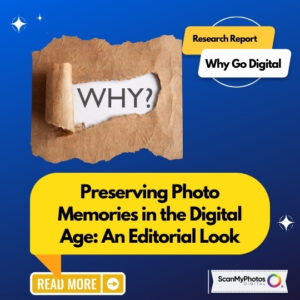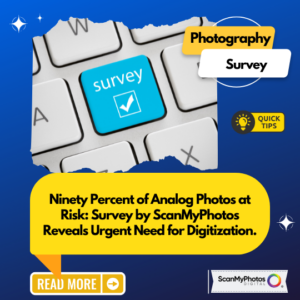Preserving Photo Memories in the Digital Age: An Editorial Look
 In an increasingly digital world, how we store and protect our most cherished memories has become a topic of growing importance. Photographs, once preserved in albums or shoeboxes, are now increasingly stored digitally. But what drives this shift from physical to digital archiving, and why is it crucial to act now?
In an increasingly digital world, how we store and protect our most cherished memories has become a topic of growing importance. Photographs, once preserved in albums or shoeboxes, are now increasingly stored digitally. But what drives this shift from physical to digital archiving, and why is it crucial to act now?
The Vulnerability of Physical Photographs
While printed photos once represented the standard for preserving memories, they are far from permanent. Photographs, negatives, and slides are prone to degradation. Over time, images fade, colors shift, and paper deteriorates. Environmental factors like humidity, sunlight, or improper storage can irreversibly damage photos.
The fragility of physical photos is especially concerning in the face of natural disasters, which occur more frequently worldwide. Fires, floods, hurricanes, or even minor accidents like water damage can permanently lose irreplaceable moments captured on film.
According to a study by the U.S. National Archives, even under ideal storage conditions, printed photographs can degrade over time, and color images may show signs of fading within as few as 20 years. This has prompted individuals and institutions alike to rethink their approach to photo preservation.
Unveiling the Past: How ScanMyPhotos Digitized 57 Years of Cayman Islands History
Digital Archiving: A Modern Solution to an Age-Old Problem
The digital era offers a compelling alternative to these risks. You create a backup immune to environmental damage by converting physical photos into digital files. Digital archiving allows you to safeguard your images against time and the elements.
In addition, technology now offers enhanced ways to store these digital copies safely. Whether saved to external drives, cloud services, or both, digital backups offer redundancy—ensuring that even if one file is corrupted, another remains accessible. It’s an added layer of security that physical storage simply cannot provide.
Immediate Access and Efficient Organization
In the past, finding a particular photo could take hours of searching through stacks of albums or shoeboxes. Digital archiving changes that. Once digitized, photos can be cataloged and tagged with metadata at Mylio Photo, allowing users to search by date, event, or person.
Review: Organizing Thousands of Photos Made Easy with Mylio Photos
Advances in artificial intelligence have also made photo organization easier. Tools like facial recognition and auto-tagging can now automatically sort your images by person, location, or event. This level of organization transforms your photo collection from a chaotic assortment into an easily searchable digital library.
Space Considerations and Decluttering
Another practical benefit of digital photo archiving is space efficiency. Physical photos and albums can take up considerable space in homes, especially if accumulated over generations. However, a single terabyte drive or cloud storage plan can hold tens of thousands of photos in a compact, accessible format.
For individuals looking to downsize or declutter, digitizing offers a way to retain access to memories while freeing up valuable physical storage. This can especially appeal to those moving to smaller homes or organizing estates.
The Growing Need to Digitize Now
Many people delay the digitization process, often underestimating the urgency. But time works against the preservation of physical media. The longer you wait, the greater the risk of your photos deteriorating beyond repair.
There’s also the evolving issue of technology obsolescence. Some older formats, such as VHS tapes or film reels, are becoming harder to access as playback equipment disappears. Neglecting to convert older photos and videos now could mean losing access to them altogether.
As the Library of Congress noted, proactive digitization is a form of preservation insurance. Acting now ensures that the quality of the original media is preserved before further damage or decay occurs.
A Case Study: Kenneth in Colorado
A Colorado resident, Kenneth experienced firsthand the risks of relying solely on physical photo storage. After a minor roof leak, boxes of old family photos were nearly ruined. “I realized just how fragile my photo collection was,” he recalls. “If I hadn’t digitized them when I did, they could have been lost forever.”
Stories like Kenneth’s highlight the importance of early action. Digitizing your photos protects them from physical risks and ensures they can be accessed and enjoyed by future generations.
Conclusion: A Vital Step in Protecting Your Memories
Digital photo archiving is not just a convenience; it’s a necessary step in safeguarding your personal history. The threat of time, environmental damage, and technological obsolescence make digitization essential for anyone looking to preserve their memories.
By digitizing now, you ensure that your family’s history remains intact, accessible, and ready to be shared for years. In today’s uncertain world, protecting what matters most is more important than ever.
Call to Action:
Want to learn more about digital photo archiving? Visit photo scanning and archival services like ScanMyPhotos.com to discover the benefits of digitizing your family’s memories. With cutting-edge technology and professional care, ScanMyPhotos helps preserve your legacy for future generations. Start protecting your memories today.




